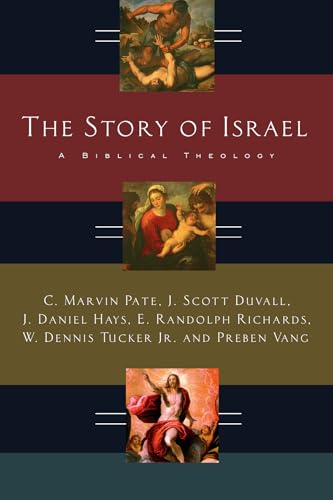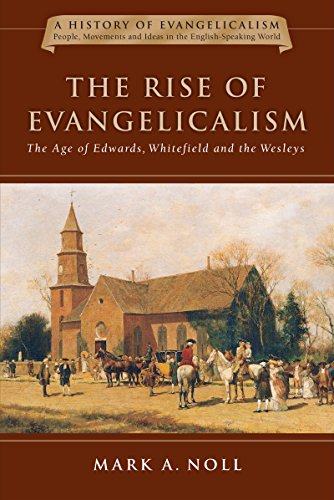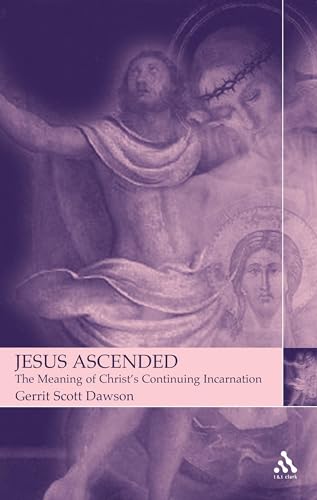The Story of Israel: A Biblical Theology
Written by C. Marvin Pate, J. Scott Duvall, J. Daniel Hays, E. Randolph Richards, W. Dennis Tucker Jr., and Preben Vang Reviewed By Charles L. EcholsIn the preface, the authors state that the purpose of the book is ‘to produce an overarching biblical theology that stresses large connecting motifs, a theology that attempts to step back from the trees for a moment and look at the forest as a whole’ (9). The introductory chapter (Pate) restates the purpose more boldly, asserting that there is, in fact, a prevailing theme which unifies the OT and NT. It acknowledges that the claim is controversial, and is chiefly a question for biblical theology. As a result it reviews the two major periods in modern scholarship which responded to the discipline of biblical theology. The first period (1787–1878) followed a rationalist approach, which emphasised the diversity of Scripture and therefore rejected the discipline. The second period (post WWII—1960s) rejected rationalism and upheld biblical theology for reasons including a belief in the unity of the Bible and its uniqueness in the ancient Near East. Although these tenets were criticised in the 1960s, and the movement declined somewhat, it nevertheless enjoys contemporary support from various related fields (e.g., canonical criticism). Pate follows the work of O.H. Steck (1967), who argued that the literature of Second Temple Judaism was dominated by the Deuteronomistic perspective of the history of Israel, which had five aspects: ‘Israel’s perpetual disobedience to God’, ‘Israel and the prophets’, ‘Israel’s rejection of the prophets’, ‘Israel and the Deuteronomic curses’, and ‘The restoration of Israel and the Deuteronomic blessings’ (Pate, 20–21, summarising Steck). Steck qualified that not all five needed to be present for a text to be considered Deuteronomistic, so that the perspective has bearing on the NT. Pate thus claims that story of Israel ‘qualif[ies] to be characterized as a biblical theology in its own right’ (23). He reduces Steck’s five aspects to an overarching pattern of sin, exile and restoration, and the rest of the book details how the pattern appears in the major units of the Bible.
The first unit is the Pentateuch (ch. 2, Tucker), where the theme first appears in Genesis 3–11, in which sin led to ‘expulsion and wandering’ (33). Genesis 12–50, however, presents an instance of restoration through Abraham, who is blessed by Yahweh, and thus becomes the conveyor of blessing to the nations (Gen. 12:1–3). With the Book of the Covenant (Exod. 20–23), Yahweh makes the Israelites his people. As such they are to adhere to the laws that are stipulated in the covenant, with the promise of blessing for obedience and curse for disobedience. The blessing/curse theme continues in Leviticus 26. However, it adds the restoration component: should Israel go into exile from persistent disobedience, Yahweh will bring restoration if the nation confesses its sins. According to Tucker, Deuteronomy provides ‘the hermeneutical key to the entire Pentateuch’ (42), since it both emphasises the need for obedience and articulates most extensively the restoration dimension (Deut. 30:1–10).
The next section (ch. 3, Hays) covers the historical books (Josh.—2 Kgs). Theologically and thematically these books show a strong connection with Deuteronomy, so much so that Deuteronomy through to 2 Kings are commonly referred to as the ‘Deuteronomistic history’. The unit begins positively: in Joshua, God’s promise of the land to Abraham is fulfilled with the seizure of Canaan. We also find an instance of the blessing/curse pattern in Rahab, a Canaanite, who is blessed for heeding the request for sanctuary by Joshua’s two spies (Josh. 6:17, 25). Another instance of this pattern can be found in Achan, an Israelite, who is cursed for disobeying Joshua’s instructions regarding the spoil (Josh. 7). This example is especially significant since Rahab’s incorporation into the Israelite community (Josh. 6:25) conveys the theological idea—based on God’s promise to bless the nations through Abraham (Gen. 12:3)—that the true Israelite is ultimately determined by “faith in God’s promises” rather than by ethnicity (54). Although things begin well, the book of Joshua contains ‘certain hints of foreboding [which] foreshadow the disastrous future’, e.g. for instance, Joshua 13:13 (55). Despite God’s promise of blessing, the nation persistently disobeys; and although instances of restoration arise (e.g., Ruth, Samuel, David), the sin-exile aspects predominate the remainder of the unit.
Chapter 4 (Tucker) considers the Psalms and Wisdom literature. On the former, the historical psalms contain references to all three aspects of the overarching theme: sin (e.g., Pss. 78:10–11, 40; 106:14, 28), exile (e.g., Pss. 78:58–59, 60; 106:41) and restoration (e.g., Ps. 136:23–24). Although Tucker concedes that ‘very little of the story of Israel can be found in much of the Wisdom literature’ (76), he maintains that this corpus is relevant on the individual rather than the corporate level vis-à-vis Deuteronomistic theology, i.e. obedience leads to prosperity, while disobedience results in disaster. Proverbs 3:1–12 and 6:20–35, for example, reflect Deuteronomy 6:4–9 and 5:6–18/6:4–9, respectively.
The prophets (ch. 5, Hays) are divided into pre-exilic and exilic prophets. The former functioned as ‘Yahweh’s prosecuting attorneys’ (93), who charged Israel with disobedience to Mosaic law in three general areas: sin (idolatry), social injustice and religious ritualism. They warned that, according to the Mosaic covenant, failure to repent would bring judgement and, ultimately, exile. Yet both the pre- and post-exilic prophets looked to a future, messianic/eschatological restoration that is based on the unconditional Abrahamic and Davidic covenants as well as the new covenant which is written on the heart rather than stone. Hays remarks that the amount of prophetic material which pertains to restoration is small compared with that on sin and exile. Nevertheless, it is this material which is emphasised by NT writers as connecting with their witness. Hence, the prophetic material pertaining to restoration is critical to the unity of the two Testaments.
A chapter on Second Temple Judaism (Pate) follows the thesis of N.T. Wright that ‘Jewish intertestamental literature’ centred on the question of how ‘Israel could be “restored” to her land but still remain in exile’ (106). According to Pate (106), the Deuteronomistic tradition (which he equates with the sin-exile-restoration theme, 105) is expressed through four types of Second Temple literature: ‘theocratic’ (e.g., 1 Maccabees, Sirach), ‘apocalyptic’ (e.g., 4 Ezra, 2 Baruch), apologetic (e.g., The Wisdom of Solomon, 4 Maccabees) and ‘sectarian apocalyptic’ (e.g., 1 Enoch, Jubilees). All four are marked by nomism and particularism, which are incongruent with the prophets” admonition against ritualism and the Abrahamic covenant’s inclusion of the nations.
The Gospels are addressed in two chapters: the Synoptic Gospels (ch. 7, Vang) and the Gospel of John (ch. 8, Richards). The Synoptics evince Israel’s misunderstanding of God’s involvement with its history. Using Mark as the basis for discussion, Vang traces several aspects of Israel’s story. As an example of restoration, the arrival of Jesus the Messiah indicates the return of the presence of God among his people. Jesus is also recognised as the suffering servant of Isaiah, through whom the nations will be reached. However, the Synoptics understand that disbelieving Jews remain in exile. In Jesus’ confrontations with the Jewish leaders, for example, they indicate that the leadership misinterpreted the law as well as the identity and role of the Messiah. Moreover, the parable of the fig tree reveals God’s rejection of Israel’s worship (149). The resurrection of Jesus, furthermore, validates Jesus’ teachings, terminates the exile and initiates the new age. The Gospel of John, while strikingly different from the Synoptics, nevertheless shares a number of key motifs (e.g., Jewish leadership’s misperception of Jesus). The major themes in John (e.g., the Book of Signs, 1:19–12:50) all contribute to the central purpose of demonstrating that Jesus offers restoration to Israel and to the nations.
Although the treatment of the Acts of the Apostles (ch. 9, Vang) focuses on the first nine chapters, Luke, throughout Acts, ‘use[s] historical events as a vehicle for teaching without losing the integrity of the historical events themselves’ (178). Indeed, Luke uses the same methodology in his gospel. God’s ‘eternal purpose’ had been for Israel to be a light to the nations; but because Israel had misunderstood, he would now use ‘the new Israel, Jesus’ disciples, who are empowered by the presence of God’s spirit’ (186). This idea is embodied in Stephen’s speech (Acts 7), which, in condemning the Jewish leadership for disobeying the law (7:53), and (according to Vang) implying that the new covenant includes Jews and Gentiles, stands as ‘the climactic center pole in Acts’ (198).
The Pauline corpus is considered in chapter 10 (Pate). Whereas the gospels understand the crucifixion as Jesus receiving the Deuteronomistic curse so that his followers could receive the Deuteronomic blessing, Paul argues that even attempting to follow the law results in curse, whereas placing faith in Jesus brings blessing. For support, Pate draws upon Romans 1:16–3:31; 2 Corinthians 3:1–4:6; Galatians 3:10–14; Ephesians; Colossians; and 1 Thessalonians 2:15–16. Galatians 3:10–14, for example, explains the idea through a structural syllogism: transgressing the law leads to curse, no one can keep the law, therefore all who seek justification through keeping the law are cursed. By dying on a tree, Christ—who kept the law perfectly—took on our curse, so that we may receive the Abrahamic blessing through faith. Hence, the Deuteronomic curse is reversed. Since the law brings death and condemned the innocent Jesus, it is flawed and to be replaced by Christ as the vehicle of God’s revelation.
Neither 1, 2 Peter, James, Jude, nor Hebrews address the entire story of Israel (chapter ch. 11, Richards), but ‘most use one aspect’ (252). James and 1 Peter, for example, write from a context of living in exile and waiting for restoration.
The Revelation to John (ch. 12, Duvall) ‘draws together in spectacular fashion the central elements of the story of Israel—sin, exile, and restoration’ (255). Written at a time when Christians experienced pressure to worship false gods, Revelation reassures believers that the Creator of the cosmos will bring it to its conclusion and remains worthy of sole adoration. Duvall observes many parallels between Revelation and the OT, for instance, keeping God’s commandments (cf. Deut.; Rev. 1:3) and the fulfilment of OT prophecies such as the blessing of the nations through Abraham (cf. Gen. 12:1–3; Rev. 7:9–12). Moreover, Revelation portends the ultimate exile for God’s enemies (e.g., Rev. 6:1–8:1) and the restoration of his people. On the latter, Revelation 21–22 has many allusions to the reverse of the curse in Genesis 3 and the downward spiral in Genesis 4–11.
A final chapter (Duvall) concludes that one or more aspects of the sin-exile-restoration pattern occur in each of the main sections of the Bible, which validates the authors’ thesis that the story of Israel is a theme which spans Scripture.
The preface of the book states: ‘Our prayer for this work is that it will become an important tool of study for students, professors and ministers as well as for informed laity as they come to understand their own faith in light of the fulfilment of Israel’s story in Jesus the Messiah’ (9). As a guide to biblical study, the book is well-suited to students and informed laypersons since it provides a useful overview of most of the books of the Bible and highlights some of the critical issues. Moreover, each chapter concludes with sections of suggested further reading and study questions. The latter generally pertain to the main points of the chapter, but occasionally probe further. The suggested readings, however, are restricted to entries from the New Dictionary of Biblical Theology (InterVarsity Press)—the exception being chapter 8, which also refers to the Dictionary of Jesus and the Gospels (InterVarsity Press). The omission of other basic reference works such as the Anchor Bible Dictionary (Doubleday) is also regrettable. These factors plus the explanations of basic historical events (e.g., Babylon’s double invasion of Judah, 91, n. 6) and the definitions of standard terms (e.g., ‘Deuteronomic history’, 18, n. 21; ‘Apocrypha’, 105, n. 1; ‘inclusio’, 248, n. 56) indicate that the book will leave scholars wanting. As a means of nurturing faith through seeing ‘the fulfilment of Israel’s story in Jesus’, however, the book will be beneficial to each member of its targeted audience.
One problem with the book is the insufficient attention to the change in what constitutes ‘Israel’ with the advent of the NT, i.e. the shift from ethnic to spiritual Israel. It is inadequate, for example, to distinguish between the Jewish people and the Jewish leadership (e.g., 195–96), since it was not only Israel’s leaders who rejected Jesus. To be sure, the authors certainly distinguish between old and new Israel in several places (e.g., 186, 194, 204, 246), but readers would benefit from a section specifically devoted to this important topic. A second difficulty is the fact that some biblical material is largely irrelevant to the book’s theme. The section on Wisdom literature is a case in point (cf. also the book’s index), where Tucker acknowledges that little of these texts applies directly to the story of Israel (76).
These problems lead to a third difficulty: namely, the use of the Deuteronomistic history in the definition of the story of Israel. The authors claim that ‘the story of Israel, conceived in a particular way, is a prevailing pattern in Scripture’ (12). As mentioned, the introduction appears to associate the ‘particular way’ with the five aspects of the Deuteronomistic history as identified by Steck. The ‘particular way’ is then reduced to ‘the pattern of sin-exile-restoration’ (22), with the qualification that a text need not ‘contain all five elements in order for it to be framed by the Deuteronomistic perspective’ (23). The Deuteronomistic history is thus equivalent to the pattern of sin-exile-restoration, a predominate pattern in the OT and NT (23). The question is why the book labours to identify the patterns of sin-exile-restoration pattern and blessing/curse with the Deuteronomistic history, when both appear in places which are not, strictly speaking, Deuteronomistic.
The authors’ task would be much simpler by claiming that the sin-exile-pattern is ubiquitous in Scripture, and that the blessing/curse pattern likewise occurs outside the Deuteronomistic history. This would allow the patterns to be discussed sequentially in the canon without having to associate each occurrence with the Deuteronomistic history. For example, the first complete instance of the sin-exile-restoration pattern occurs in the Flood narrative (Gen. 6:1–9:19), which is well before the Deuteronomistic history. Similarly, the Promised Land, while one of the ‘Deuteronomic’ blessings (44), has its provenance in the Abrahamic covenant, as does the incorporation of the Gentiles into the people of God (Gen. 15, 17)—a prominent theme in Acts, and indeed in the NT.
A more general view of the sin-exile-restoration pattern would also facilitate the distinction between the historical and figurative senses of ‘exile’, which the book presupposes. The Flood, for instance, is not a literal exile (cf. 2 Kgs. 17:6, 25:20–21); nor is a literal exile intended by Pate (e.g., 106), when he affirms N.T. Wright’s thesis that inter-testamental literature was primarily interested in how the Jews could remain in exile, despite having been restored to the land.
These criticisms do not undermine the book’s thesis, but rather refine it. The authors have successfully demonstrated successfully that the story of Israel applies to enough of the Biblical material to be justified as a theme by which the Bible can be viewed comprehensively. As the field of biblical studies continues to diverge into ever-narrower specialisations, it has become increasingly difficult for OT and NT scholars to converse; and, indeed, the question of whether the discontinuity between the OT and NT is so great as to preclude any meaningful connection remains on the table for many scholars The authors have, therefore, made a significant contribution by demonstrating that there is an organic unity to the Bible, and we are grateful to view the forest.
Charles L. Echols
Stapleford







